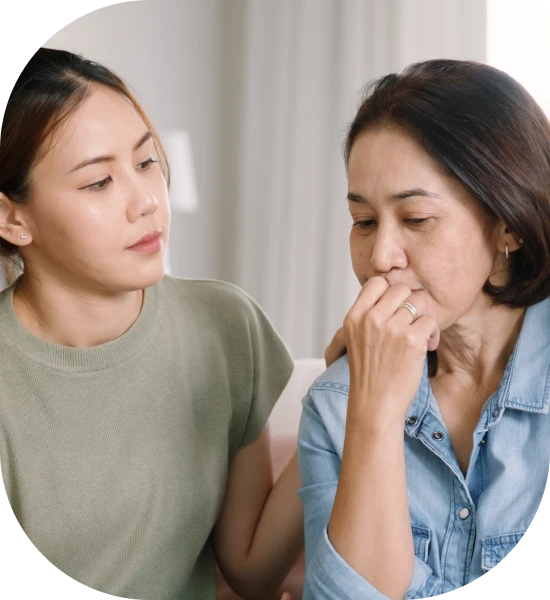Chronic bloating. Lower back pain. Fatigue that lingers even after rest. These are symptoms […]

Endometriosis is a condition whereby tissue that lines your uterine cavity grows outside the cavity in locations such as the fallopian tubes, ovaries, bowels and abdominal cavity. If endometriosis forms in the ovaries, they can form ovarian endometriomas, or “chocolate” cysts, named due to their appearance of old blood akin to chocolate. The World Health Organisation (WHO) estimates that endometriosis affects 1 in 10 of women in the reproductive age group globally.
Some women with bad endometriosis do not have any symptoms at all; other women with superficial or mild endometriosis may get debilitating symptoms. In general, symptoms of endometriosis can include:
Painful periods (dysmenorrhea)
This can start before the onset of menstruation, worsen throughout the period and may get better as the period ends. In worsening endometriosis, one may sometimes find that the pain gets chronic i.e. lasts throughout the period and persists even when one is not having periods, becoming chronic pelvic pain.
Painful bowel movements (dyschezia)
Severe rectal pain during a bowel movement when one is on their period – this is usually related to bowel endometriosis
Urinary symptoms
Women with bladder endometriosis can sometimes experience painful urination, blood in the urine, urinary frequency and painful voiding.
Painful sex (dyspareunia)
As endometriosis involves the supportive ligaments of the uterus (uterosacral ligaments), and causes distortion of the pelvic anatomy e.g. the vagina and uterus gets stuck to the rectum and penetration results in pulling and stretching of these fibrotic tissue, this can result in physical pain especially during deep penetration. Over time, sexual dysfunction arising from endometriosis can affect relationships.
Female infertility
Distortion of the female pelvis with endometriosis can cause swollen or blocked fallopian tubes, destruction of ovarian structure and function if the ovaries get involved in endometriomas, the general inflammatory state of the pelvis in reaction to the endometrial tissue found outside the uterus etc.
If left untreated, endometriosis can progressively get worse with time. This is because endometriosis requires the female hormone estrogen to grow and develop – hence its prevalence in women of the reproductive age group.
The most common theory why endometrial tissue is found outside the uterus is attributed to retrograde menstruation, whereby menstrual blood, rather than flowing out of a woman’s body through the vagina, backflows through the fallopian tubes and makes its way into the pelvis and abdominal cavity to implant and grow.
Unfortunately, due to lack of awareness on both patients and healthcare professionals, misconceptions that women should just “deal with menstrual cramps as a normal part of a woman’s life and get on with it”, Endometriosis UK[1] estimates that it takes an average of 7.5 years for women with endometriosis to get an accurate diagnosis, when it really shouldn’t be the case.
Read: When to see a doctor for painful period cramps
The American Society for Reproductive Medicine (ASRM) classifies endometriosis into 4 stages[2] – according to the number of lesions and depth of infiltration.
There is a point system used to numerically quantify the disease:
Endometriotic lesions can also be superficial or deep – the latter can invade organs such as the uterus and its supportive ligaments (uterosacral ligaments), ovaries, bowels, appendix, diaphragm, and can significantly distort anatomy.
It is important to note, however, that the stage and score of the disease does not necessarily correlate to the severity of symptoms or pain that the patient may be experiencing.
In a paper published by the American Journal of Obstetrics and Gynaecology[2], where they sought to clarify the progression of endometriosis with a cohort of 690 women with laparoscopically confirmed endometriosis, they found that endometriosis progressed at a mean rate of 0.3 point per month in terms of the revised American Fertility Society Score.
That may not necessarily apply to all women with endometriosis, as retrograde menstruation and its rate may not necessarily occur every cycle, but it is important to note that endometriosis can and usually will progress with time if left untreated.
If endometriosis is left untreated and the disease progresses, one may end up with increasingly severe symptoms that may disrupt one’s ability to function in everyday life, as well as interfere with interpersonal relationships.
For those who desire fertility and envision future children in their lives, endometriosis that is either not diagnosed, diagnosed late or left untreated can irreversibly damage one’s reproductive potential.
If you suspect that you may be having endometriosis, please see a gynaecologist with expertise in diagnosing and treating endometriosis early, as it is imperative that you obtain an accurate diagnosis and commence on appropriate treatment as soon as possible.
Laparoscopy used to be the gold standard in diagnosing endometriosis but that is no longer the case in present day management of endometriosis.
Although there is no definitive cure for endometriosis, there are medical and surgical options that can go a long way in relieving you of your symptoms and preserving your fertility potential; these treatment options need to be individualized depending on age, symptoms, severity of endometriosis and fertility requirements. Common treatment options include:
Medical hormonal suppression is typically instituted before and after (until the woman desires to get pregnant). It is also important to know that endometriosis has a high chance of recurrence even after surgical excision, hence medical suppression should be strongly considered for women not seeking pregnancy immediately after surgery, as it can significantly reduce recurrence rates.
Managing endometriosis at home alone e.g. using warm packs and taking over-the-counter painkillers, although helpful in easing menstrual cramps, is not helpful in resolving this chronic and long-term condition.
However, there are adjunct things you can do to help with managing your endometriosis. In addition to the treatment options highlighted above, I recommend adopting lifestyle changes with incorporation of a healthy diet and regular exercise, stress modulation, and joining support groups to connect with women sharing your same diagnosis.
References:
https://www.endometriosis-uk.org/it-takes-average-75-years-get-diagnosis-endometriosis-it-shouldnt
https://www.ajog.org/article/0002-9378(93)90649-4/pdf#:~:text=In%20terms%20of%20the%20revised,Society%20score%20by%20about%2050%25
Chronic bloating. Lower back pain. Fatigue that lingers even after rest. These are symptoms […]
Many women live with Polycystic Ovary Syndrome (PCOS) without realising fact from fiction. This […]
Within the realm of women’s health, the terms “fibroids” and “cysts” are often mentioned […]





Aster Gynaecology © | All Rights Reserved.